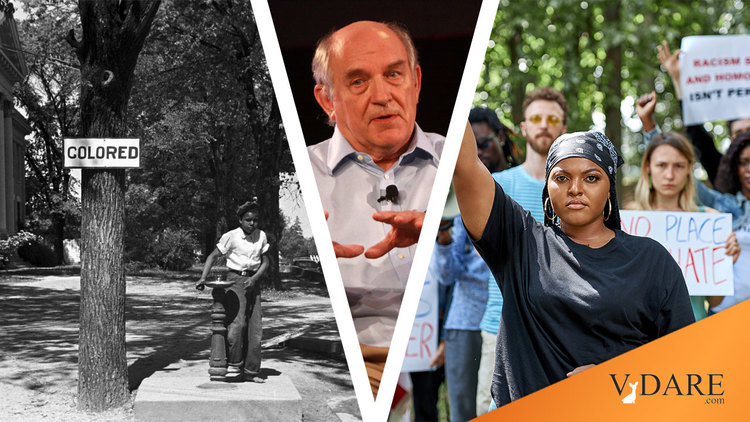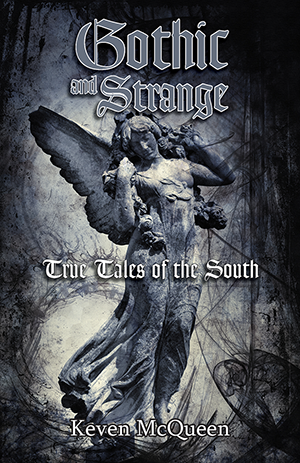


07/30/2021
Earlier, by Paul Gottfried: Did Pre-MLK America Really Need Redemption?
I’m going to offer for your consideration what Winston Churchill would have called a naughty question. Here’s my naughty question: Is Jim Snow worse than Jim Crow?
I need to define terms here. For 245 years this country of ours has lived more or less uncomfortably with the fact that a big minority of its population is black while the rest, the majority, isn’t. The size of the minority has dwindled some since Independence, when we were 16 percent black; today it’s 13 percent.
You can break that 245 years into three segments, marked off by two significant events: the end of the Civil War in 1865, and then the Civil Rights revolution, for which the 1964 Civil Rights Act is a convenient marker. That gives you 89 years of slavery, 99 years of Jim Crow, and 57 years of Jim Snow.
Those latter two segments are what I’m comparing: Jim Crow, when blacks were under legal disabilities in some states and social disabilities most everywhere, and Jim Snow, when blacks enjoy preferences and favoritism, "racism" is a sin of well-nigh religious gravity, and a white person who expresses negativity towards blacks is excluded from polite society and social media.
When asking "Is Jim Snow worse than Jim Crow?" I also need to define "worse." Worse how? Worse for whom? I'll answer both together with just: worse for our country. Is the U.S.A. more stable, more harmonious, more fair, safer, happier under Jim Snow than it was under Jim Crow?
Even with those definitions spelled out, I still don’t really have a question you can get to grips with. Those 99 years of Jim Crow covered a lot of social change. Jim Crow 1890, Jim Crow 1920, and Jim Crow 1950 were very different Americas. Take lynchings, for instance. The numbers for those three years were 96, 61 — and two [Lynching Statistics by Year And Race, UMKC School of Law].
It was the Jim Crow of the 1950s that the Civil Rights activists wanted to reform, though: a country pretty much like today’s, with widespread prosperity, a welfare state, modern media and communications, and so on; and all well within living memory.
So here’s my naughty question more precisely phrased: With the race issue in mind, is the Jim Snow America of 2021 more stable, more harmonious, more fair, safer, happier than the Jim Crow America of 1950?
I’m looking for a balance sheet of pros and cons. There is, for example, racial unfairness in both countries. Under 1950 Jim Crow a less capable white person might get hired over a more capable black because the boss didn’t want blacks around. Under 2021 Jim Snow a less capable black person might get hired over a more capable white because the company fears discrimination lawsuits if they don’t hire enough blacks.
Those are different unfairnesses, but they're both unfair to the guy who didn’t get hired.
Or take the matter of ordinary everyday human dignity. For sure there were offenses against dignity in Jim Crow America, when an adult black man had to put up with being called "boy." But then, in Jim Snow America adult white people will lose their jobs if they don’t sit quiet and obedient through a company-sponsored seminar about how evil and oppressive they are and how ashamed of their ancestors they should be.
So, just as with unfairness, there are indignities on both sides of the balance sheet.
Likewise with safety. Take homicide as the extreme. In 1950 whites sometimes killed blacks and vice versa; same today. What are the numbers? How does the balance sheet work out?
And then, harmony. You've been reading a lot in recent months about the demonization of whiteness: negativity towards whites in schools, colleges, and corporations. Was there something balancing in 1950s Jim Crow America? Was there negative propaganda demonizing blackness? I suppose there was some; but again, what does the balance sheet look like?
So there’s my naughty question. I leave it with you to discuss among yourselves. I have some guesses I could offer; but as an old math major, I'd like to see the answer in good quantitative form.
Perhaps one of our universities could assign it as a research project in the social sciences…
I know I’ve already sent some readers to the fainting couch. For goodness sake, Derb, don’t you know that Jim Crow America in 1950 was a hell on earth for blacks? It was like North Korea for them! They tiptoed around in terror of saying the wrong word or looking the wrong way at someone! Any one of them, at any time, could have the door of his cabin kicked down in the middle of the night and be dragged off to be lynched! Haven’t you heard of Emmett Till?
Sure, I know the common Narrative. It’s what I call “The Romance of American Blackness.” I use the definition of the word "romantic" given in Webster’s Third:
…marked by the imaginative or emotional appeal of the heroic, adventurous, remote, mysterious, or idealized characteristics of things, places, people.
We love a romance, all of us do. That’s why there has always been myth and legend. That’s why there are novels, plays, and movies. Apart from the simple emotional pleasures of romance, it spares us the mental effort of extracting an accurate picture of reality from the buzzing clouds of information that assault our senses.
For example, I mentioned lynching back there. Here once again are the numbers of Americans lynched for 1890, 1920, and 1950: 96, 61, and two. Of those numbers, how many were not black?
A great many people would be baffled to be asked that. Why, they were all black, weren’t they? Wasn’t that what lynching was all about, whites killing blacks?
Actually, no. In those three years, the numbers of whites lynched were 11, 8, and 1. In percentages: 11, 13, and 50.
No, I didn’t cherry-pick; those were normal numbers for the Jim Crow years. And yes, that’s still a lot more blacks than whites; but blacks have had high levels of violent criminality for as long as we've kept records. So given that lynchees were lynched for something they were believed to have done, and surely in many cases had done, there was bound to be racial imbalance.

The closer you look, the more the lynching Narrative collapses. Keven McQueen, in his book Gothic and Strange True Tales of the South, lists numerous counter-Narrative lynchings. In Clarksville, Tennessee in 1914 a white man who'd raped a black woman was hanged by a black mob. ("The coroner’s jury decided it was a justifiable homicide and freed the black lynchers.")
Blacks sometimes lynched blacks. As late as 1948 in Savannah, Georgia, police had to rescue a black man, Frank Mack, from a black mob who were on the point of lynching him for robbing and beating a popular white pharmacist.
Perhaps most counter-Narrative of all: In Columbia, Louisiana, 1891, a white mob lynched a white man for having "shot an elderly black woman named Hager Sterling to death."
The Romance of American Blackness is just that, a romance. It wasn’t reality. Reality was black and white people living out ordinary lives of work and love in a society that had some customary unfairness and indignity built in, and that was very occasionally blighted by acts of criminal brutality — just like Jim Snow America.
Reality was what you hear if you talk to whites and blacks who grew up under Jim Crow, or if you read memoirs like Little Richard’s story of growing up in Georgia in the ‘30s. Reality was the old lady who grew up poor white in Alabama, who I met twenty years ago when she was custodian of the Hank Williams birthplace in Georgiana, AL. I asked her about race in Jim Crow Alabama. Quote:
We didn’t mix much. Our schools were separate, of course. Not that different, though, that I could see. Their school had a teacher; our school had a teacher. They had a stove; we had a stove.
"They had a stove; we had a stove." That’s ordinary life. It’s ordinary: sometimes unfair, occasionally cruel, but hardly ever romantic. That’s reality.
The problem is, reality isn’t anything like as popular as romance.
Charles Murray’s latest book has the title Facing Reality: Two Truths about Race in America. I gave it a brief review in my May Diary. Steve did a much more penetrating full review at Taki’s Magazine; and geneticist Razib Khan has just posted an even fuller review over at Quillette.com [Charles Murray’s ‘Facing Reality’ — A Review, July 29, 2021].
Razib, who is a friend of Murray’s (and an occasional acquaintance of mine) struggles not very successfully to keep from sinking into despair:
Those already familiar with the data on racial differences in cognitive tests and crime rates, and therefore predisposed to take Murray’s book seriously, will most likely give up on engagement due to intellectual exhaustion with today’s punitive and spiteful political climate. And those who might benefit from Murray’s book will not read it because it was written by someone who transmits ritual pollution to all those who acknowledge him.
Executive summary: nobody’s much interested in reality. People in the generality prefer romance. When reality shows its face, in a news story for example, we process it through a romantic filter.
Case in point: Tony Timpa. Ever heard of him? Probably not. Tony Timpa was a guy who died in 2016 while resisting arrest in Dallas, Texas. One of the restraining officers used his knee to pin Timpa face down for 13 minutes waiting for paramedics to arrive. There’s bodycam footage on YouTube if you'd like to watch it.
Tony Timpa died while under that knee restraint; of "cocaine and the stress associated with physical restraint," according to the autopsy report [Police laughed and joked as he lost consciousness in handcuffs. Minutes later, he died, by Reis Thebault, Washington Post, July 31, 2019].
So those restraining officers are serving long jail sentences, right?
And Tony Timpa’s family got an eight-digit settlement from the city of Dallas, right?
And it’s considered the height of bad manners to mention Tony Timpa’s long criminal record, right?
Wrong on all three. Those officers are still on duty. Dallas paid nothing to Timpa’s family. So far as I can discover, Timpa had no criminal record at all. Tony Timpa was white, you see. His story didn’t make it through that romantic filter.
This is where I let loose my inner geezer. I've been going to and fro in the earth, and walking up and down in it, for several decades now. I was never in Jim Crow America; but I've known people that were, and done some listening and reading.
So: is the Jim Snow America of 2021 more stable, more harmonious, more fair, safer, happier than the Jim Crow America of 1950? My honest best guess is: no. And I am sure that the America of 1950 was more accepting of reality than we are here today, under Jim Snow. Way more accepting. Razib again:
Serenity evades us as long as we build upon a foundation of lies.
Charles Murray wrote this latest book, he tells us, as a warning: If we don’t return to a more balanced, more realistic view of human nature, he says, there will be a rising resentment among white Americans against the Jim Snow order, with unpleasant consequences.
In Murray’s preferred state of society, people accept reality, including the reality of race differences, and social advancement is strictly meritocratic, without racial favor or disfavor. He says this meritocratic Murraytopia is what we should strive for. If we don’t, then white resentment will eventually boil over, and we'll be back to something like Jim Crow.
I say he’s dreaming, and I think Razib agrees. To swallow reality, as laid out by Murray, you need to be able to think in a formally quantitative way about statistical distributions. How many people can do that? It takes a somewhat above-average intelligence: I'd guess an IQ of 110 or more. That’s 25 percent of whites but only five percent of blacks: nothing like enough to propel us to Murraytopia. Sorry, Charles, no sale.
So, what’s in our future?
A harmonious, meritocratic Murraytopia?
A return to Jim Crow, or something like it, when whites get fed up at last with the injustices and indignities of Jim Snow?
Or an almighty social upheaval when, to quote Razib yet again, "we'll have to face reality with 21st-century solutions to our problems."
Place your bets, ladies and gentlemen.

John Derbyshire writes an incredible amount on all sorts of subjects for all kinds of outlets. (This no longer includes National Review, whose editors had some kind of tantrum and fired him.) He is the author of We Are Doomed: Reclaiming Conservative Pessimism and several other books. He has had two books published by VDARE.com com: FROM THE DISSIDENT RIGHT (also available in Kindle) and FROM THE DISSIDENT RIGHT II: ESSAYS 2013.
For years he’s been podcasting at Radio Derb, now available at VDARE.com for no charge. His writings are archived at JohnDerbyshire.com.
Readers who wish to donate (tax deductible) funds specifically earmarked for John Derbyshire’s writings at VDARE.com can do so here.